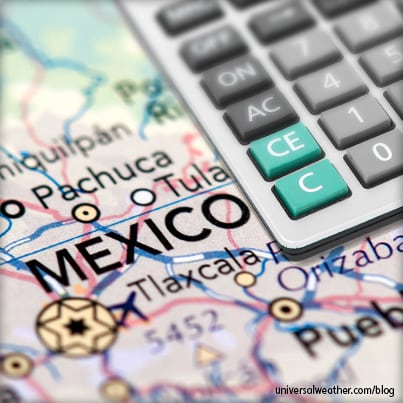Mexico’s SENEAM Fee and Business Aviation – Part Two: Paying SENEAM Fees

This business aviation blog post continues from our previous post entitled Mexico’s SENEAM Fee and Business Aviation – Part One: Explaining SENEAM fees.
While there are many parameters to consider when dealing with SENEAM fee payment issues, the process can become manageable when it and the requirements that must be met are known. Its best practice to clear up any past-due payments as soon as possible. Operators with past-due SENEAM fees will face significant future operating challenges. It’s not worth the risk of having your aircraft detained or denied entry into Mexican airspace as a result of delinquent charges.
Here are some answers to FAQs on paying Mexico’s SENEAM fees:
1. What’s the best way to calculate outstanding SEMEAM fees?
Have your 3rd-party provider determine if you owe any SENEAM fees prior attempting to overfly Mexican airspace. A 3rd-party provider will need a signed letter from the operator, signed by two witnesses, authorizing the provider to check with SENEAM on outstanding fees. This letter must be in Spanish and include operator name, name of the representing 3rd-party provider, aircraft type, and tail number. It must be signed by someone who works for the operator, but it does not have to be on company letterhead or notarized. While this process can take time, SENEAM will advise on fees due for a particular tail number. This fee total, however, will not include late fees or outstanding daily interest.
2. How do operators pay outstanding SENEAM fees?
SENEAM fee references are by tail number, not operator name. This means if an aircraft is sold and the same tail number is used, a new operator could be responsible for past SENEAM fees owed. To make overflight fee payments, an operator should go on the SENEAM Web site and obtain a user number to cover all aircraft in a particular flight department or organization. This user number is used to pay all SENEAM fees owed for all aircraft in a particular fleet. It’s important to advise SENEAM whenever you buy or sell an aircraft. Be aware that “actualization fees” will be applied whenever operators have fees outstanding over a long period of time. This means that you’ll not only pay the overflight charges in effect at the time of overflight, but you’ll also pay fee increases put in place over time. If, for example, you overflew Mexico in 2005, when SENEAM fees were 5 pesos per km, you’ll pay these charges plus the difference in fee rates between 2005 and 2012. Making these calculations can be very complex, particularly when adding late charges and daily interest to the mix. Operators are advised to have 3rd-party providers undertake this task for them.
3. How are outstanding SENEAM fees paid?
Once you have a SENEAM user number, you’ll fill out a form and send a wire transfer to SENEAM along with this form. SENEAM will review, hopefully accept payment, and forward their determination to two other government departments for approval. Once all three parties have approved payment, instructions will be forwarded to the airport so that your aircraft may be released if you were detained on the ground due to outstanding fees. Keep in mind that if any of these responsible government individuals are not available, or if the request is made outside regular business hours, the process will be delayed. Best-case scenario for SENEAM fee acceptance is about three hours. Keep in mind that government departments in Mexico operate 0900-1700 local Monday-Friday and are closed on weekends and Mexican holidays.
4. Is the process really as straightforward and user-friendly as it sounds?
No, there is the potential for complexities when settling outstanding SENEAM fees. You’ll need to correctly calculate actualization, late fees, and daily interest owed in order to settle the payment process correctly. If you underpay, you’ll remain in past-due status and will be denied the right to overfly Mexico. If you overpay, this does not give you a credit toward future SENEAM fees, and it will be difficult to retrieve overpaid amounts. In event of overpayment, you’ll need to send a formal request to the Office of Revenue, who in turn will contact SENEAM to verify excess amount paid. Once the Office of Revenue receives an official confirmation from SENEAM, they’ll return the overpayment via wire transfer.
5. What’s the best way to avoid issues?
Begin working with your 3rd-party provider now to determine if your aircraft has any outstanding SENEAM fees. You may have charges that you’re not responsible for, but it will take time to prove that charges due are not correct. Your aircraft may, for example, be owned by a bank that has other tail numbers in overdue status. SENEAM may require certain documentation to prove you’re not responsible for charges that may have been accrued to a bank, financial institution, or other entity listed on your ownership papers. If you’re a new operator of the aircraft, you’ll be responsible for any outstanding SENEAM overflight charges until you can prove otherwise.
6. What are some best practice tips?
Be proactive in determining if you have outstanding SENEAM fees. Track all of your Mexican overflights and instances of overtime at Mexican airports. Keep a record of SENEAM fee calculations and payments you’ve made. It’s good practice to keep a logbook recording all Mexican overflights, along with wire transfer payments, to SENEAM.
Conclusion
The good news is SENEAM fee challenges will disappear so long as operators are proactive reporting and paying fees. Keep in mind that it’s always easier to have a 3rd-party provider handle the multitude of complexities and calculations involved.
Questions?
If you have any questions about this article, contact Juan Muniz at juanmuniz@univ-wea.com.




